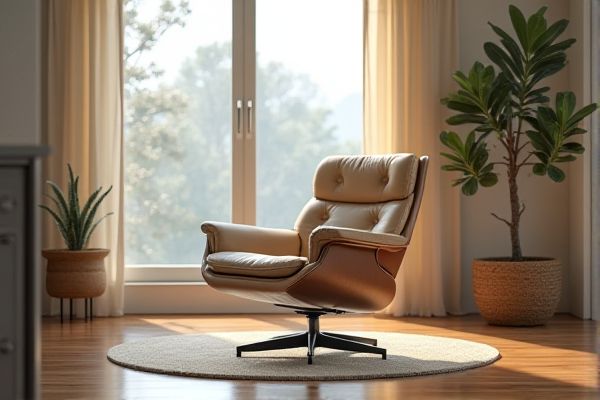
Swivel chairs offer enhanced mobility and flexibility, allowing you to rotate effortlessly for multitasking and easy access to different areas of your workspace, while stationary chairs provide stability and often support better posture for long hours of focused work. Explore the rest of the article to discover which chair type best suits your needs and workspace setup.
Table of Comparison
| Feature | Swivel Chair | Stationary Chair |
|---|---|---|
| Mobility | 360deg rotation for easy movement | No rotation, fixed position |
| Functionality | Enhances multitasking and reach | Stable, focused seating |
| Use Case | Office, conference rooms, desks | Dining, lounge, waiting areas |
| Adjustability | Often features height and tilt adjustments | Generally fixed height and backrest |
| Space Efficiency | Requires clearance for rotation | Compact, no clearance needed |
| Cost | Typically higher due to mechanics | Usually more affordable |
| Durability | More moving parts may need maintenance | Fewer parts, generally longer-lasting |
Introduction to Swivel and Stationary Chairs
Swivel chairs feature a rotating seat mechanism that allows users to turn freely, enhancing mobility and convenience in workspace environments. Stationary chairs remain fixed in position, offering stable support without movement, ideal for tasks requiring steady posture. Choosing between swivel and stationary chairs depends on the specific ergonomic needs and functional requirements of a workspace.
Key Features of Swivel Chairs
Swivel chairs offer 360-degree rotation, enhancing mobility and ease of access in dynamic work environments. Equipped with adjustable height, a rotating seat, and often caster wheels, these chairs provide ergonomic support and flexibility for multitasking. Your productivity benefits from the ability to move freely without standing, making swivel chairs ideal for office and creative spaces.
Key Features of Stationary Chairs
Stationary chairs are designed with fixed legs that provide stability and support without any rotational movement, making them ideal for environments where steady seating is crucial. These chairs often feature ergonomic cushioning, durable frames, and various materials like wood, metal, or plastic to suit different aesthetic and functional needs. Your choice of a stationary chair ensures consistent posture alignment and is perfect for tasks requiring minimal movement.
Ergonomic Benefits Comparison
Swivel chairs offer dynamic movement that enhances ergonomic benefits by allowing you to easily reach different areas of your workspace without straining your body, promoting better posture and reducing repetitive stress injuries. Stationary chairs provide stable support but limit mobility, which may lead to increased muscle tension and discomfort during prolonged use. Choosing a swivel chair can improve comfort and efficiency by accommodating natural body movements and minimizing the risk of musculoskeletal problems.
Space and Mobility Considerations
Swivel chairs offer superior mobility, allowing you to easily rotate and reach different areas of your workspace without standing up, making them ideal for dynamic tasks and collaborative environments. In contrast, stationary chairs are designed for fixed positions, providing stable support but limiting movement, which might be beneficial in tight spaces where chair rotation could disrupt your setup. Choosing between a swivel chair and a stationary chair depends on your space constraints and the level of mobility your work demands.
Design and Style Differences
Swivel chairs feature a rotating base that allows 360-degree movement, enhancing flexibility in workspace environments, while stationary chairs have fixed legs, offering a more traditional and stable seating option. Swivel chairs often incorporate ergonomic designs with adjustable heights and contemporary materials, making them suitable for modern office aesthetics. Stationary chairs tend to emphasize classic styles with varied upholstery and solid construction, aligning well with formal or minimalistic decor.
Suitability for Different Work Environments
Swivel chairs offer enhanced mobility and flexibility, making them ideal for dynamic work environments that require frequent reaching, multitasking, or collaboration. Stationary chairs provide superior stability and support, suited for tasks demanding prolonged sitting without extensive movement, such as focused desk work or meetings. Choosing your chair depends on whether your work environment emphasizes movement and interaction or sustained, stationary productivity.
Maintenance and Durability Factors
Swivel chairs typically feature moving parts such as bearings and gas lifts that require regular maintenance to prevent wear and ensure smooth rotation, while stationary chairs have fewer mechanical components, resulting in lower upkeep demands. The durability of swivel chairs can be affected by the quality of these components, making it essential to choose models with robust construction and high-grade materials to extend lifespan. Your choice between the two should consider how maintenance needs align with your usage frequency and whether you prioritize long-term resilience or simplicity.
Price Range and Value Comparison
Swivel chairs typically range from $100 to $500, offering adjustable features and mobility that enhance productivity and comfort, making them a cost-effective investment for office or home use. Stationary chairs generally cost between $50 and $300, providing stable seating but lacking the ergonomic versatility of swivel models. Evaluating value depends on user needs: swivel chairs justify higher prices through ergonomic benefits and flexibility, while stationary chairs offer affordability with simpler design and less functionality.
Choosing the Right Chair for Your Needs
Swivel chairs offer enhanced mobility and flexibility, allowing you to rotate easily and access multiple areas without standing up, making them ideal for dynamic workspaces. Stationary chairs provide stable support and are often preferred for tasks requiring consistent posture and minimal movement. Evaluating your work environment and movement requirements ensures you choose the right chair that aligns with your comfort and productivity needs.
 homyna.com
homyna.com